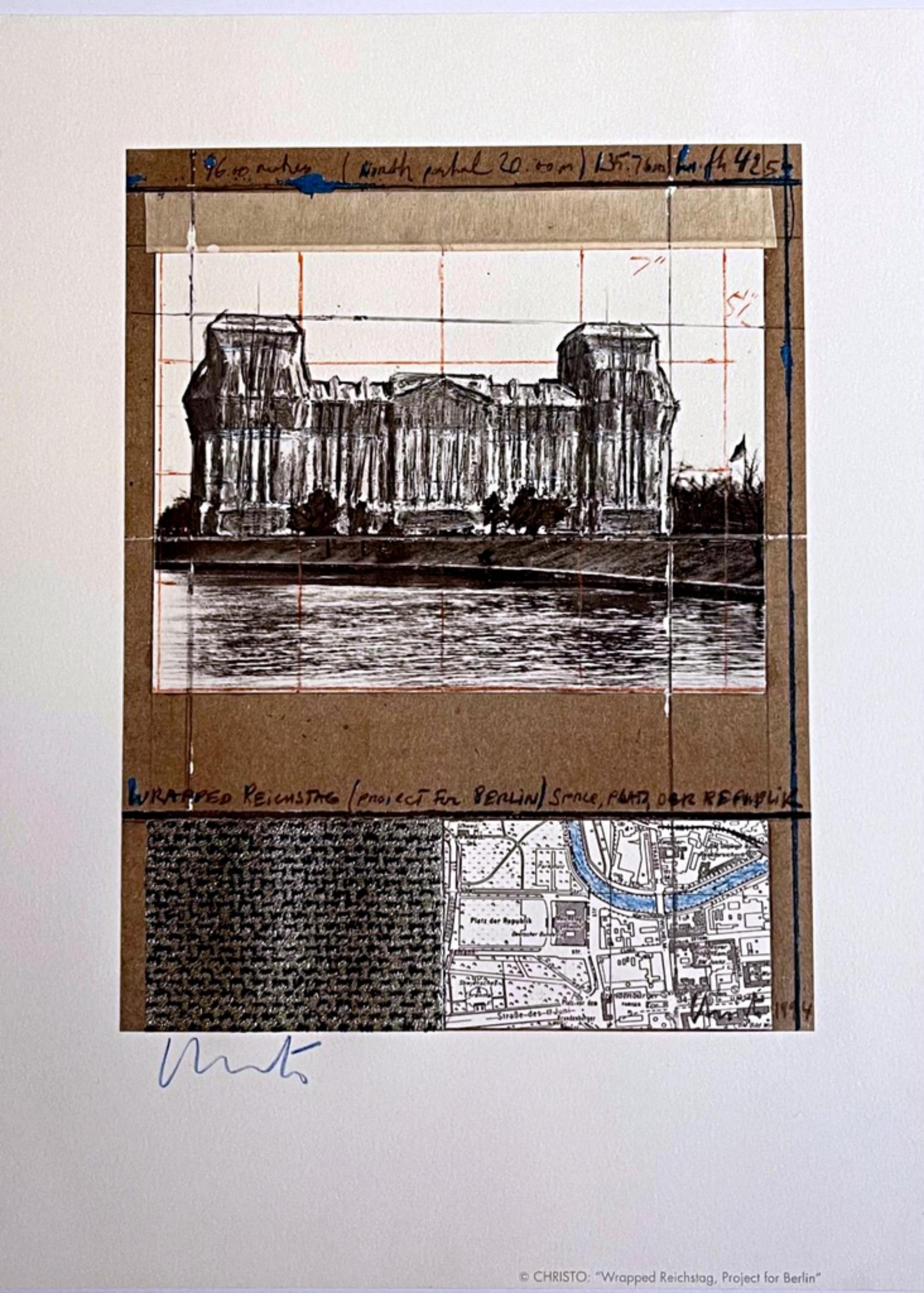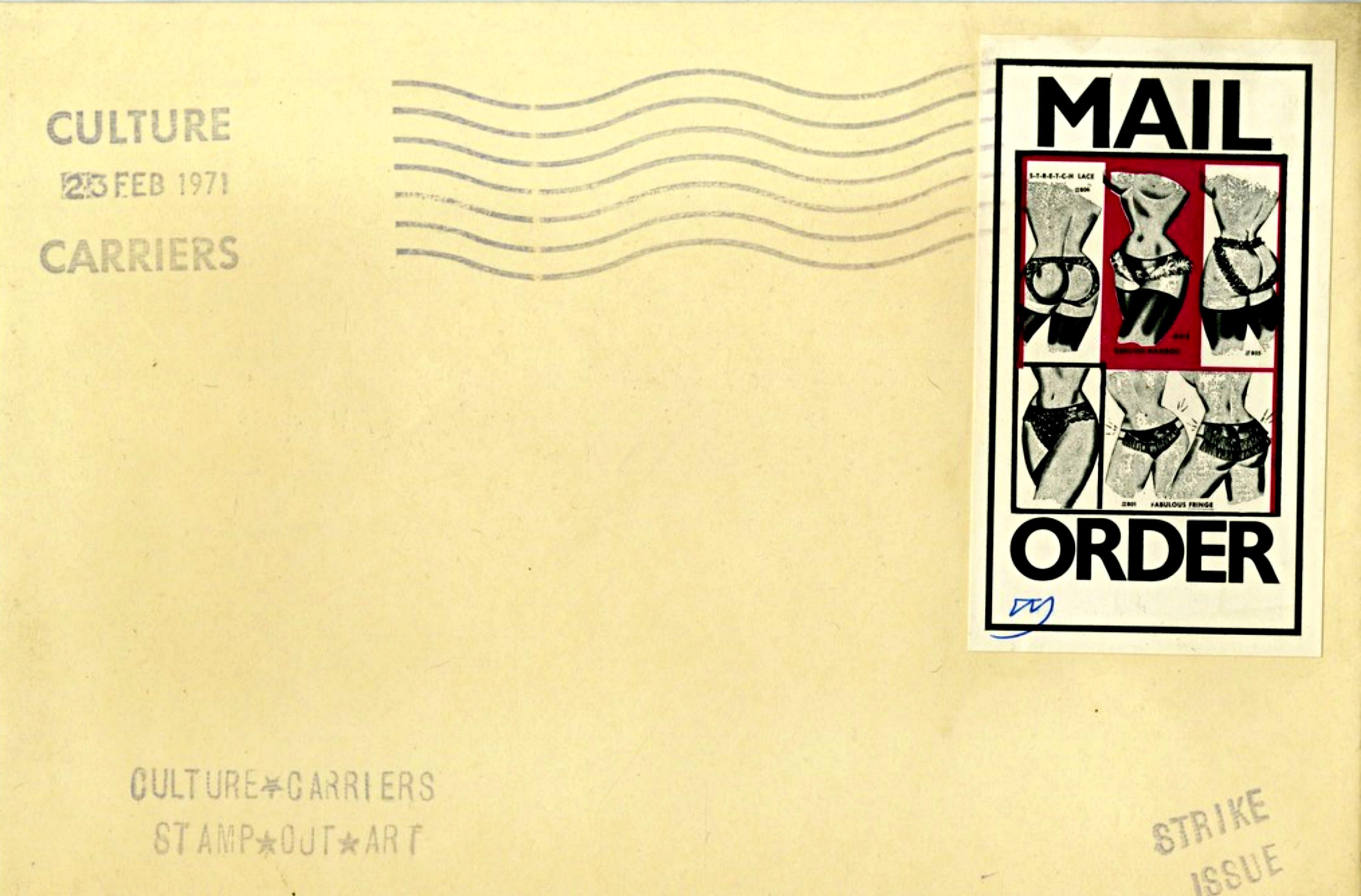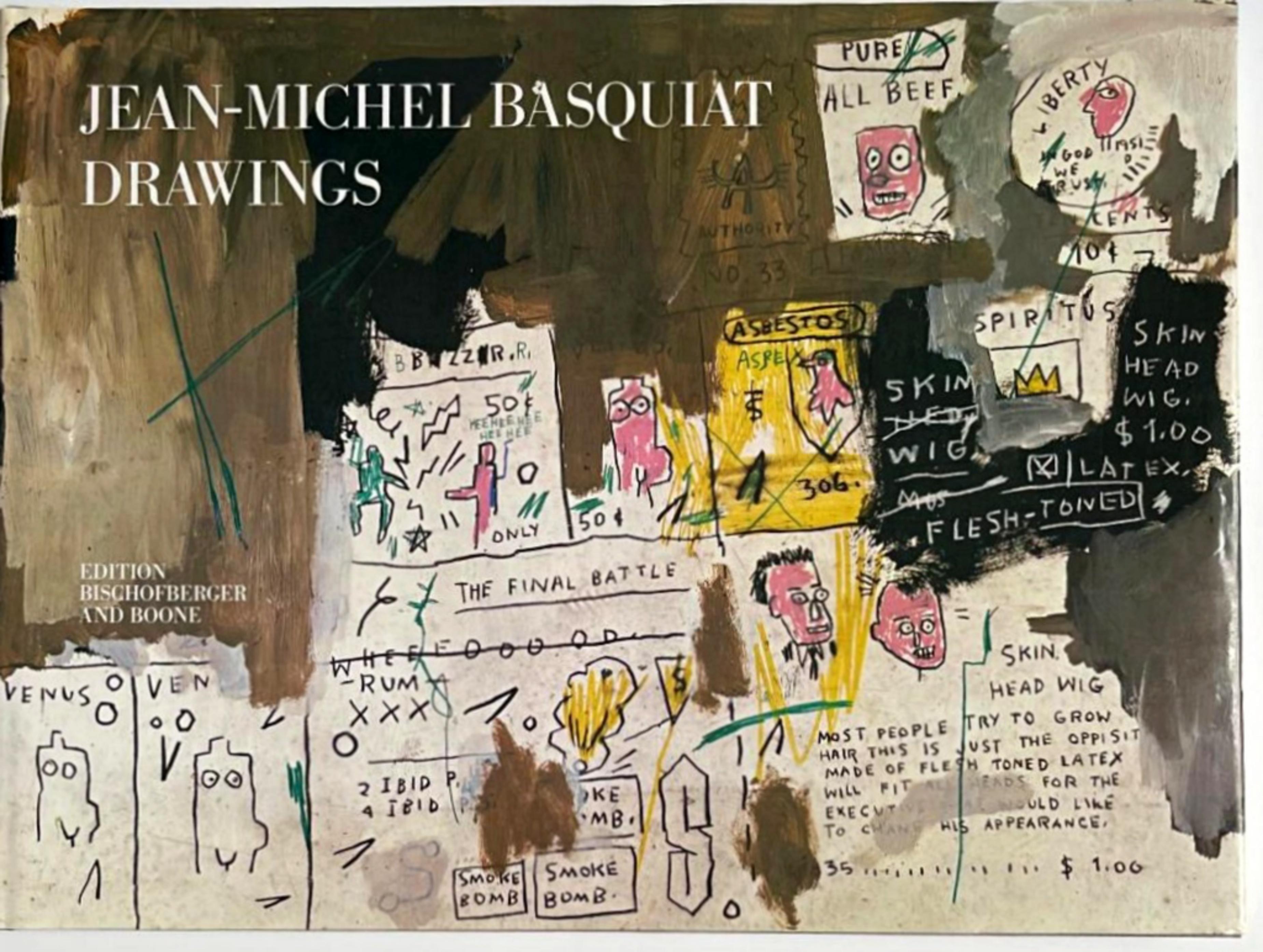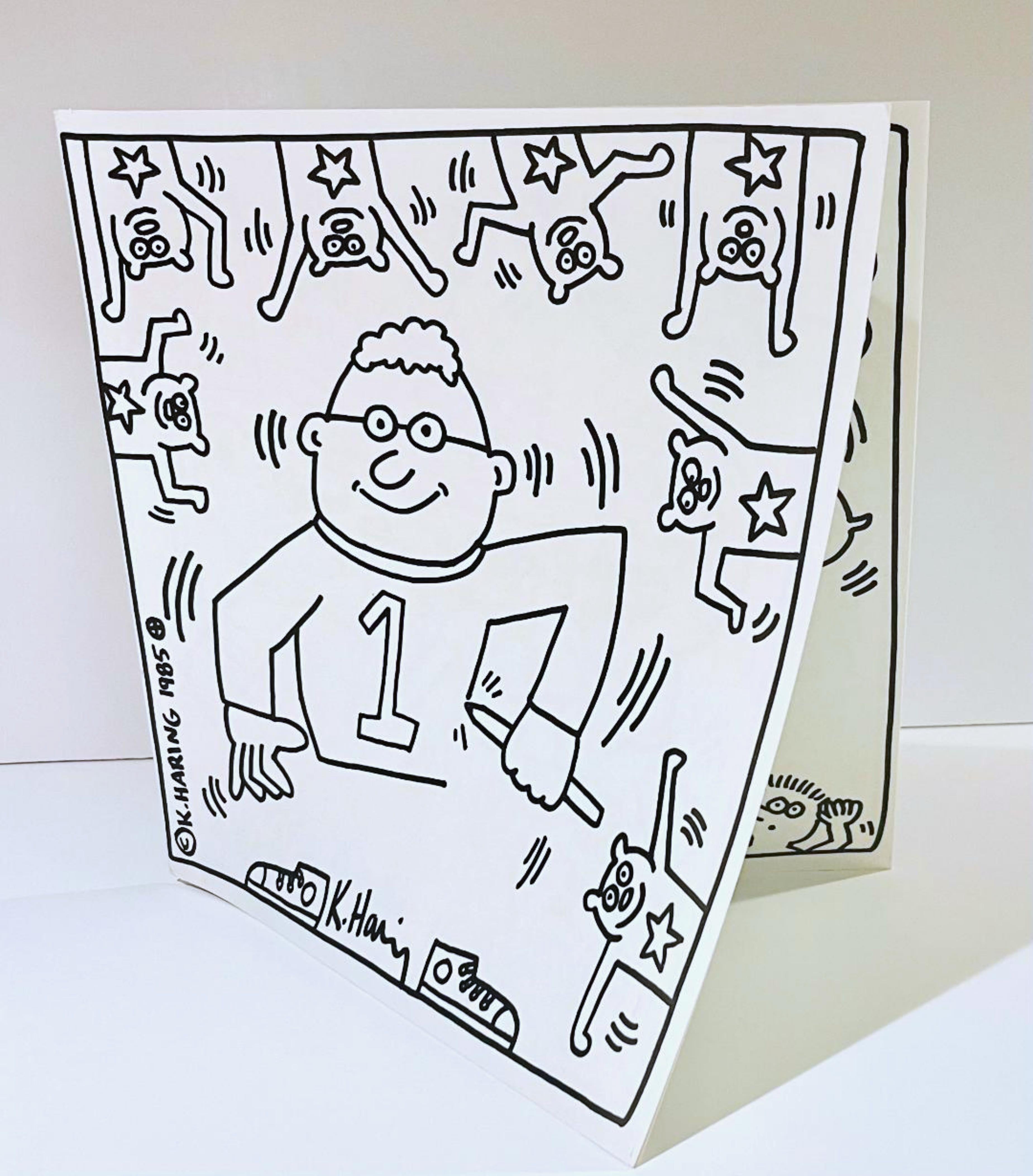Items Similar to 1982 Basquiat Rome announcement (Jean-Michel Basquiat 1982)
Want more images or videos?
Request additional images or videos from the seller
1 of 5
after Jean-Michel Basquiat1982 Basquiat Rome announcement (Jean-Michel Basquiat 1982) 1982
1982
About the Item
Basquiat Rome 1982:
Rare, highly sought-after original catalog/exhibition card to Basquiat's 1982 Rome show at Galleria Mario Diacono, Italy. Opening to four panels, the extensive red engraved text, is among the very first set of catalogue information on the artist. Text in part, discusses the origins of the famous Basquiat 1982 work, The Field Next to the Other Road (Il campo vicino l'altra strada), which was painted by Basquiat in Modena in 1981 then exhibited as a single exhibition piece at Diacomo gallery in 1982. One of the rarest and earliest printed materials related to Jean-Michel Basquiat.
Fine wove card stock with detailed red letterpress.
9.5 x 6 7/8 inches (closed)
Very good to excellent condition with the exception of some minor corner wear.
Text by in Italian by gallerist Mario Diacono.
Unsigned from a scarce edition of unknown. Rare.
Basquiat and 1982:
“For Basquiat, it all converges in 1982,” said the legendary dealer Jeffrey Deitch. “Those of us who were there at the time and saw those paintings just couldn’t believe it. The level of achievement was just astonishing. It was almost a miracle,” he remembered.
In 1982, on the other hand, Basquiat “wasn’t making paintings because he had to give them to Bishofberger for his stipend, or for his show at Mary Boone,” said Deitch. “He was making them because he was compelled to make them, so they are filled with personal passion.”
A series of important exhibitions throughout 1982 also created great momentum for - and, later, the desirability of his work from that year. His first New York solo show with Annina Nosei kicked things off. After came solos at Gagosian Gallery in Los Angeles, Bruno Bischofberger in Zurich, and another New York solo show at Fun Gallery. A February group show at Alexander F. Milliken Gallery presented Basquiat’s now-$110.5 million painting for the first time. That year, he was also included in his first major international institutional exhibition: Documenta, an influential show of contemporary art that takes place in Kassel, Germany, every five years.
This succession of shows in 1982 also served to jumpstart Basquiat’s market; it was the year, Galperin said, “when collectors started to acquire his work en masse.” Nosei was said to be selling his paintings at a breakneck pace—“So brisk, some observers joked, that the paint was barely dry,” Cathleen McGuigan wrote in the 1985 New York Times profile.
Jean-Michel Basquiat was an influential African-American artist who rose to success during the 1980s. Basquiat’s paintings are largely responsible for elevating graffiti artists into the realm of the New York gallery scene. His spray-painted crowns and scribbled words referenced everything from his Haitian and Puerto Rican heritage, to political issues, pop-culture icons, and Biblical verse. The gestural marks and expressive nature of his work not only aligned him with the street art of Keith Haring and Kenny Scharf, but also the Neo-Expressionists Julian Schnabel and David Salle. “If you wanna talk about influence, man, then you've got to realize that influence is not influence,” he said of his process. “It's simply someone's idea going through my new mind.” Born on December 22, 1960 in Brooklyn, NY, Basquiat never finished high school but developed an appreciation for art as a youth, from his many visits to the Brooklyn Museum of Art with his mother. His early work consisted of spray painting buildings and trains in downtown New York alongside his friend Al Diaz. The artist’s tag was the now infamous pseudonym SAMO. After quickly rising to fame in the early 1980s, Basquiat was befriended by many celebrities and artists, including Andy Warhol, with whom he made several collaborative works. At only 27, his troubles with fame and drug addiction led to his tragic death from a heroin overdose on August 12, 1988 in New York, NY. The Whitney Museum of American Art held the artist’s first retrospective from October 1992 to February 1993. In 2017, after having set Basquiat’s auction record the previous year with a $57.3 million purchase, the Japanese billionaire Yusaku Maezawa surpassed it, buying the artist’s Untitled (1982) at Sotheby's for $110.5 million. This set a new record for the highest price ever paid at auction for an American artist's work. Today, Basquiat's works are held in the collections of The Museum of Modern Art in New York, the Rubell Family Collection in Miami, and the Museum of Contemporary Art in Los Angeles, among others.
Related Categories
Basquiat Annina Nosei. Emilio Mazzoli. Basquiat Modena. SAMO. Basquiat 1982. Early Basquiat. Basquiat posters.
- Creator:after Jean-Michel Basquiat (2001, American)
- Creation Year:1982
- Dimensions:Height: 9.5 in (24.13 cm)Width: 6.9 in (17.53 cm)
- Medium:
- Movement & Style:
- Period:
- Condition:Very good.
- Gallery Location:NEW YORK, NY
- Reference Number:1stDibs: LU35434218601
About the Seller
5.0
Vetted Seller
These experienced sellers undergo a comprehensive evaluation by our team of in-house experts.
Established in 2014
1stDibs seller since 2016
4,238 sales on 1stDibs
Typical response time: <1 hour
- ShippingRetrieving quote...Ships From: New York, NY
- Return PolicyThis item cannot be returned.
More From This SellerView All
- Keith Haring Paris 1987 (Keith Haring Pompidou)By Keith HaringLocated in NEW YORK, NYKeith Haring Paris, 1987: Well-suited for framing, this vibrant oversized illustrated bag was designed by Keith Haring during his lifetime for the P...Category
1980s Pop Art Abstract Prints
MaterialsPlastic, Offset, Lithograph
- Basquiat Keith Haring Andy Warhol Record Art (set of 4)By after Jean-Michel BasquiatLocated in NEW YORK, NYBasquiat, Keith Haring & Andy Warhol record art. A set of 4 vintage record albums from 1977-2001 making for standout wall art. Featured within ...Category
1980s Pop Art Mixed Media
MaterialsLithograph, Offset
- 1980s Keith Haring Record Art: set of works (Keith Haring album art)By Keith HaringLocated in NEW YORK, NY1980s Keith Haring Record Art (set of 4 works): Four individual 12 inch albums - all illustrated by Haring during his lifetime - making for standout vintage 1980s Keith Haring wall ...Category
1980s Pop Art Prints and Multiples
MaterialsOffset, Lithograph
- Robert Rauschenberg Talking Heads Speaking in Tongues (new/sealed)By Robert RauschenbergLocated in NEW YORK, NYRare unopened Robert Rauschenberg designed Talking Heads Speaking in Tongues: In 1983, legendary pop artist Robert Rauschenberg designed the album cover for Talking Heads’ acclaimed...Category
1980s Pop Art Mixed Media
MaterialsLithograph, Offset
- Rare Andy Warhol Record Cover Art set of 4 (Andy Warhol album art)By Andy WarholLocated in NEW YORK, NYAndy Warhol Record Art 1982-1986: Set of 4 Andy Warhol illustrated record covers (accompanied by their original records): Warhol's classic rendition of Miguel Bose, Aretha Franklin, ...Category
1980s Pop Art Mixed Media
MaterialsLithograph, Offset
- Andy Warhol album cover art 1986 (Andy Warhol Debbie Harry)By Andy WarholLocated in NEW YORK, NY1986 Andy Warhol record art featuring Debbie Harry. Featured prominently in 'Andy Warhol: The Record Covers, 1949-1987, a Catalog Raisonne' by Warhol scholar Paul Marechal. Off-se...Category
1980s Pop Art Prints and Multiples
MaterialsLithograph, Offset
You May Also Like
- Wrapped Reichstag, Berlin, collage with raised thermal silver paper, hand signedBy ChristoLocated in New York, NYChristo Wrapped Reichstag: Project for Berlin, 1994 Collage on offset lithograph with raised silver thermal paper used to wrap Reichstag, on thin velincarton 15 3/4 × 11 1/2 inches E...Category
1990s Pop Art Landscape Prints
MaterialsFabric, Mixed Media, Offset, Crayon, Lithograph
- British Pop: Mail Order, for Culture Carriers Stamp Out Art (Lt Ed signed stamp)By Allen JonesLocated in New York, NYALLEN JONES Mail Order, for Culture Carriers Stamp Out Art, from The Collection of Art Critic Anthony Haden-Guest, 1971 Lithograph mounted on franked envelope of wove paper (Hand Signed) 6 × 9 inches Edition of 250 (unnumbered) Hand signed in blue ink by Allen Jones with his initials on the lower left of the lithographic stamp, affixed to the envelope. Unframed As a consequence of the prolonged strike by the Royal Mail postal workers in the United Kingdom, Allen Jones, along with a group of top British Pop artists of the era including David Hockney, Eduardo Paolozzi, Derek Boshier, the poet/activist Christopher Logue and Richard Hamilton, published ''Culture Carriers Stamp Out Art''to raise funds for the striking workers. The "stamps" were published in a limited edition of only 250 each (some artists, like Paolozzi and Allen Jones created more than one design), with the artists signing each by hand in blue ink with his initials on the lower right. Allen Jones "Mail Order" is an especially clever take on the project; it is at once a postage stamp (hence the title "Mail Order"), but it also refers to the popular mail order catalogues of the era. It was a particular preoccupation of Jones, who, separately, created a large lithograph called "Janet is Wearing" -- referring to his wife Janet, but playing upon the advertising jargon of the day, used in mail order catalogues. For this particular project - creating a stamp to raise money for mail carriers...Category
1970s Pop Art Abstract Prints
MaterialsOffset, Mixed Media, Lithograph, Ink
- Christo and Jeanne-Claude: Wrapped Reichstag monograph & slipcase, LT Ed SignedBy ChristoLocated in New York, NYChristo and Jeanne-Claude: Wrapped Reichstag, Berlin, 1971-1995, 1996 Hardback monograph with slipcase (hand signed and numbered - Hors Commerce edition, reserved for artists and contributors) Signed by Christo, Jeanne-Claude and photographer Wolfgang Volz and numbered numbered HC-694/HC-700 on the colophon. Also has an encased piece of the actual Reichstag wrapping! fabric! 12 × 12 × 1 1/2 inches Makes a memorable gift! It's hand signed and numbered - with a piece of the actual Reichstag wrapping fabric laid in. Signed by Christo, Jeanne-Claude and Wolfgang Volz and numbered numbered HC-694 on the colophon page (an Hors Commerce [not for sale] edition reserved for artists and collaborators) Original textured silver cloth with blue lettering on spine, housed in matching photo-illustrated slipcase, black lettering on spine. Contains an example of the original aluminum mesh used to wrap the Reichstag, framed in white cardboard (9 x 9") at inside back cover. Documentation of one of the startling and most stunning public art projects, representing the essence of conceptual art on a scale unmatched in the 20th century, one might say. 100 rock climbers abseiling down the facade of the Reichstag, without cranes or machinery being used in the project. This publication provides vivid documentation and a perspective of the extent of the project by the Bulgarian artist. His personal view, as expressed in The Guardian: "Artist - and above all architects - seek permanence," he said. "I don't. I like leaving nothing. That takes courage." His projects were funded mainly by selling preparatory drawings, always refusing sponsorship. Christo forbade the Three Tenors...Category
1990s Pop Art Landscape Prints
MaterialsMixed Media, Graphite, Lithograph, Offset
- Limited Edition Coloring Book (Artist Book of 20 Bound Offset Lithographs), 1985By Keith HaringLocated in New York, NYKeith Haring Coloring Book (Artist Book of 20 Bound Offset Lithographs), 1985, 1986 Artist Book of 20 staple bound Offset Lithographs Plate signed on cover page; with publisher and a...Category
1980s Pop Art Abstract Prints
MaterialsLithograph, Offset, Mixed Media
- Culture Carriers Stamp Out Art (Lt. Ed. hand signed stamp on franked envelope)By Joe TilsonLocated in New York, NYJOE TILSON Culture Carriers Stamp Out Art (Hand Signed), from the Collection of Art Critic Anthony Haden-Guest, 1971 Lithograph mounted on franked Air...Category
1970s Pop Art Mixed Media
MaterialsMixed Media, Lithograph, Ink, Offset
- Every Building on the Sunset Strip, 1st Edition, Signed & inscribed w/provenanceBy Ed RuschaLocated in New York, NY“I don’t have any Seine River like Monet, I’ve just got US 66 between Oklahoma and Los Angeles.” — Ed Ruscha An example of this rare Artist Book was exhibited prominently at the Museum of Modern Art in New York for the 2023-4 Ed Ruscha retrospective. Keep scrolling right of header image to see installation photographs of that exhibit to show how MoMA displayed this accordion style book with slipcase. (the last images) This is the 1966 true 1st Edition of Ed Ruscha's groundbreaking self-published artist book "Every Building on Sunset Strip." The book itself was published in an unsigned edition of 1000. However, in 1980, exceptionally, Ruscha hand signed and beautifully inscribed this book in red ink to football legend Joe Fields. (Joseph Charles Fields Jr. is an American former professional football player who was a center and guard in the National Football League for the New York Jets and the New York Giants.) This book is also in the original slipcase. Dimensions slip case: 7 5/16 x 5 13/16 x 9/16" (18.5 x 14.7 x 1.5 cm) This historic limited edition Artists Book is in the permanent collection of the Getty Museum in California which explains its importance as follows: In the 1960s, Ed Ruscha more or less reinvented the artist’s book. By turning away from the craftsmanship and luxury status that typified the livre d’artiste in favor of the artistic idea or concept, expressed simply through photographs and text, Ruscha opened the genre to the possibilities of mass-production and distribution. The 25-foot length of the accordion-folded Every Building on the Sunset Strip affords the viewer two continuous photographic views of the mile and a half section of this landmark stretch of Sunset, one for each side of one of the city’s landmark thoroughfare. Among many other institutions, it also in the permanent collection of MOMA, which describes "Every Building on the Sunset Strip" thus: Ruscha's photography books are antithetical to the traditional limited-edition livre d'artiste, or artist's book. Their banal subject matter and documentary style are indebted to the remarkable pictures of signs and vernacular architecture that American photographer Walker Evans made in the 1930s, but their deadpan, cool aesthetic is radically different. While each book chronicles an aspect of Los Angeles or the artist's round-trip drives between LA and Oklahoma, their use of photography as a form of map-making or topographical study signals a conceptual, rather than documentary, thrust. Edward Ruscha: Editions 1959-1999, Catalogue Raisonné, Engberg, vol. 1, ppg. 84-85 and vol. 2, pg. 124, no. B4 Publisher: Dick de Ruscha...Category
1960s Pop Art More Art
MaterialsFoil
Recently Viewed
View AllMore Ways To Browse
Basquiat The Offs Print
Gagosian Gallery
Samo Jean Michel Basquiat
Haring Exhibition Poster
Whitney Exhibition Poster
Vintage Auction Posters
Haring Catalog
Death Spray
Gallery Announcement
Keith Haring Spray Paint
Keith Haring Catalog
Keith Haring 1981
Basquiat Lithograph Poster
Retro Poster Auction
Basquiat Crown
Basquiat Catalog
Basquiat New York Times
Basquiat Exhibition Poster





